
The Spanish occupation of Tangier between 1940 and 1945 was a temporary enlargement of the Spanish Morocco during World War II.

The Spanish occupation of Tangier between 1940 and 1945 was a temporary enlargement of the Spanish Morocco during World War II.

During World War II, the Tangier International Zone was invaded and occupied by Francoist Spain.
On 14 June 1940, a few days after the Italian declaration of war after the German invasion of France, Spain seized the opportunity and, amid the collapse of the French Third Republic, a contingent of 4,000 Moorish soldiers based in the Spanish Morocco occupied the Tangier International Zone, meeting no resistance. [1]
Historians claim that it was done with the excuse that it was a prevention of a possible Italian conquest of Tangier.
Despite the claim that the occupation was a "provisional" measure, the operation was the realization of a long-standing wish [2] [n. 1] and prelude to a potential occupation of French Morocco that did not happen because Rabat ultimately rallied to the new Vichy regime. [4] The Mendoub, the sultan's representative, was expelled in March 1941, further undermining French influence in Tangier's affairs. [5]
Despite calls by the writer Rafael Sánchez Mazas and other Spanish nationalists to annex Tangier, the Franco regime publicly considered the occupation a temporary wartime measure. [6] A diplomatic dispute between Britain and Spain over the latter's abolition of the city's international institutions in November 1940 led to a further guarantee of British rights and a Spanish promise not to fortify the area. [7] In May 1944, although it had served as a contact point between him and the later Axis Powers during the Spanish Civil War, Franco expelled all German diplomats from the area. [8]
Following the August 1945 Paris Conference on Tangier between the United Kingdom, France, the United States and the Soviet Union, an isolated Spain accepted the conditions lined up in the former on 19 September 1945 and retired from Tangier on 11 October 1945. [9]
Tangier then returned to the pre-war status of an international zone. [10]

Paul was King of Greece, reigning from 1 April 1947 until his death in 1964. He was succeeded by his son, Constantine II.
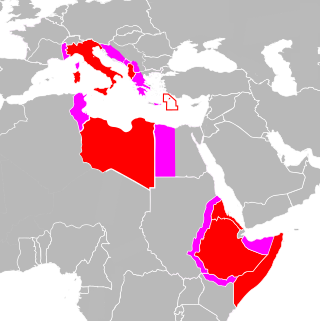
The participation of Italy in the Second World War was characterized by a complex framework of ideology, politics, and diplomacy, while its military actions were often heavily influenced by external factors. Italy joined the war as one of the Axis Powers in 1940 with a plan to concentrate Italian forces on a major offensive against the British Empire in Africa and the Middle East, known as the "parallel war", while expecting the collapse of British forces in the European theatre. The Italians bombed Mandatory Palestine, invaded Egypt and occupied British Somaliland with initial success. However, the British counterattacked, eventually necessitating German support to prevent an Italian collapse in North Africa. As the war carried on and German and Japanese actions in 1941 led to the entry of the Soviet Union and United States, respectively, into the war, the Italian plan of forcing Britain to agree to a negotiated peace settlement was foiled.

Tangier is a city in northwestern Morocco, on the coasts of the Mediterranean Sea and the Atlantic Ocean. The city is the capital of the Tanger-Tetouan-Al Hoceima region, as well as the Tangier-Assilah Prefecture of Morocco.

The French protectorate in Morocco, also known as French Morocco, was the period of French colonial rule in Morocco between 1912 and 1956. The protectorate was officially established 30 March 1912, when Sultan Abd al-Hafid signed the Treaty of Fez, though the French military occupation of Morocco had begun with the invasion of Oujda and the bombardment of Casablanca in 1907.

The Spanish protectorate in Morocco was established on 27 November 1912 by a treaty between France and Spain that converted the Spanish sphere of influence in Morocco into a formal protectorate.

The Rif or Riff, also called Rif Mountains, is a geographic region in northern Morocco. It is bordered on the north by the Mediterranean Sea and Spain and on the west by the Atlantic Ocean, and is the homeland to an indigenous people known as the Rifians. Historically, it belonged to the Rif Republic and its president, Abd el Krim, who led the Rif War from 1920 to 1927 and against a Spanish colonial empire, the Rif region was historically a Spanish Protectorate by the Spanish colonial empire in Africa. This mountainous and fertile area is bordered by Cape Spartel and Tangier to the west, by Berkane and the Moulouya River to the east, by the Mediterranean to the north, and by the Ouergha River to the south. The Rif mountains are separated into the eastern Rif mountains and western Rif mountains.

During World War II, the Spanish State under Francisco Franco espoused neutrality as its official wartime policy. This neutrality wavered at times, and "strict neutrality" gave way to "non-belligerence" after the Fall of France in June 1940. Franco wrote to Adolf Hitler offering to join the war on 19 June 1940 in exchange for help building Spain's colonial empire. Later in the same year Franco met with Hitler in Hendaye to discuss Spain's possible accession to the Axis Powers. The meeting went nowhere, but Franco did help the Axis—whose members Italy and Germany had supported him during the Spanish Civil War (1936–1939)—in various ways.
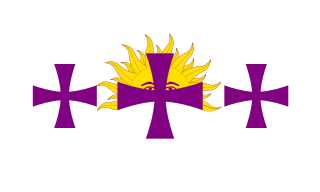
Hispanidad is a Spanish term describing a shared cultural, linguistic, or political identity among speakers of the Spanish language or members of the Hispanic diaspora. The term can have various, different implications and meanings depending on the regional, socio-political, or cultural context in which it is used.
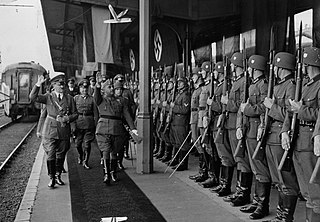
The Meeting of Hendaye, or Interview of Hendaye, took place between Francisco Franco and Adolf Hitler on 23 October 1940 at the railway station in Hendaye, France, near the Spanish–French border. The meeting was also attended by the respective foreign ministers, Ramón Serrano Suñer of Francoist Spain and Joachim von Ribbentrop of Nazi Germany.

The National Resources Mobilization Act, 1940 was a statute of the Parliament of Canada passed to provide for better planning of a much greater Canadian war effort, both overseas and in military production at home.
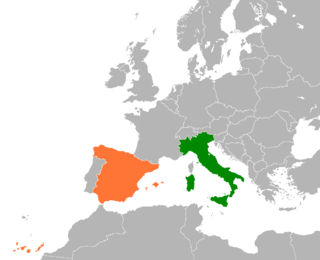
Italy–Spain relations are the interstate relations between Italy and Spain. Both countries established diplomatic relations some time after the unification of Italy in 1860.
USAT J. W. McAndrew was a Type C3-P&C troop ship for the United States Army during World War II.

Spain remained neutral throughout World War I between 28 July 1914 and 11 November 1918, and despite domestic economic difficulties, it was considered "one of the most important neutral countries in Europe by 1915". Spain had maintained a non-aligned stance during the political difficulties of pre-war Europe, and continued its neutrality after the war until the Spanish Civil War began in 1936. While there was no direct military involvement in the war, German forces were interned in Spanish Guinea in late 1915.

MoroccoandSpain maintain extensive diplomatic, commercial, and military ties. The Morocco–Spain border separates the plazas de soberanía on the Mediterranean coast from the Moroccan mainland. Morocco's foreign policy has focused on Western partners, including neighboring Spain. Relations have, however, been historically tense and conflictive.

The Tangier International Zone was a 382 km2 (147 sq mi) international zone centered on the city of Tangier, Morocco, which existed from 1925 until its reintegration into independent Morocco in 1956, with interruption during the Spanish occupation of Tangier (1940–1945), and special economic status extended until early 1960. Surrounded on the land side by the Spanish protectorate in Morocco, it was governed under a unique and complex system that involved various European nations, the United States, and the Sultan of Morocco, himself under a French protectorate.

Maurism was a conservative political movement that bloomed in Spain from 1913 around the political figure of Antonio Maura after a schism in the Conservative Party between idóneos and mauristas ('maurists'). Its development took place in a period of crisis for the dynastic parties of the Spanish Restoration regime. The movement, which fragmented in several factions in the 1920s, has been portrayed as a precursor of the Spanish radical right.

Francisco Merry y Colom, 1st Count of Benomar was a Spanish diplomat. He served as Spanish representative in Morocco after the Hispano–Moroccan War, travelling to Marrakesh in 1863. Later in his career, he also served as Ambassador in Berlin and Rome. He was the Spanish representative in the Berlin Conference.
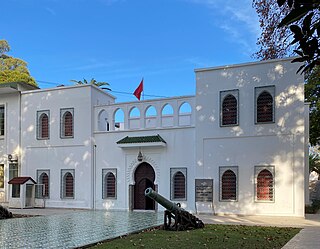
The Mendoubia or Mandubiyya refers to the former ceremonial mansion of the Mendoub, the representative of the Sultan of Morocco in the Tangier International Zone from 1924 to 1956. It now houses the commercial court of Tangier and a memorial museum.

The Mendoub or Mandub was a key official in the governance of the Tangier International Zone between 1925 and 1956, with a wartime interruption from 1940 to 1945.